Big Ten 16mm Film Collection: 16mm Films, by Title
The website devoted to the discovery of 16mm films owned by the Big Ten Acadmeic Alliance and held at the University of Iowa Libraries.
16mm Films, by Title
-
 2001, a space odyssey
by
Call Number: Motion picture 16101Publication Date: 1968OCLC#: 78557725
2001, a space odyssey
by
Call Number: Motion picture 16101Publication Date: 1968OCLC#: 78557725
From the opening sequence of prehistoric man struggling to cope with a hostile environment to the interplanetary voyage to Jupiter. It is an elegant metaphor of man’s attempts to master his fate. Throughout its entire length, director Stanley Kubrick demonstrates his unmatched mastery of sight, sound and motion as he serves a visual feast. The special effects were a quantum leap over anything that had preceded them, paving the way for the high-tech look in film and graphic design. 2001 is a milestone in the history of film. -
 À bout de souffle (Breathless)
by
Call Number: Motion Picture 16060Publication Date: 1959OCLC#: 317365812
À bout de souffle (Breathless)
by
Call Number: Motion Picture 16060Publication Date: 1959OCLC#: 317365812
Godard’s first feature film (from Francois Truffaut’s story) was conceived as a break with the traditions of quality filmmaking and a return to the directness and immediacy of the American gangster movie. The story involves a young car thief wanted by police for the shooting of a patrolman, and his relationship with an American student in Paris who subsequently informs on him, with tragic results. Godard’s critical view of the cinema as a mixed form is reflected in his use of a collage of film techniques in his “quotes” from other film makers and gangster films. Undoubtedly one of the seminal films of the sixties, its elliptical style, reflection of the existential ethos, and its individualistic approach affected many of the films that followed it into the New Wave. -
 Der Amerikanische Freund (American Friend)
by
Call Number: Motion picture 16086Publication Date: 1977OCLC#: 29406936
Der Amerikanische Freund (American Friend)
by
Call Number: Motion picture 16086Publication Date: 1977OCLC#: 29406936
Adapted from Patricia Highsmith’s suspense novel Ripley’s Game, Wenders’ bizarre thriller stars Bruno Ganz as an ordinary Hamburg picture-framer with a fatal disease who becomes involved with a mysterious, manipulative American art dealer and is persuaded to work as an assassin for a French gangster. This complex, menacing and visually rich thriller raises Wender’s favorite theme of ruthlessness and the fragility of personality to a global level by showing a world in which cities, borders, languages and cultures blur into one another. As one of many coups de theater in this film Wenders peoples his disjointed, amoral and thrillingly disorienting world with Holly wood’s greatest mavericks; Sam Fuller, Nicholas Ray and as the American friend himself, Dennis Hopper at his strangest and most disturbing -
Animated Shorts, 1957-1981 byCall Number: Motion Picture 16082Publication Date: VariousOCLC#: 823931189
Two separate of reels of animated short films with five films per reel. Reel I: A Man and His Dog by Robert Breer (b/w, 3min, 1957) T.Z. (color, 9min, 1978) Pencil Bookings by Kathy Rose (color, 14min, 1978) Two Space by Larry Cuba (b/w, 8min, 1979) and Hard Passage by Dennis Pies (color, 10 min, 1981). Reel II has: Furies by Sara Petty (color, 3min, 1975) Make Me Psychic by Sally
Cruickshank (color, 8min, 1978) Quaisi’s Cabaret Trailer (color, 3min, 1980) Crocus by Susan Pitt (color, 7min, 1971) and Asparagus (color, 19min., 1978). -
 L'Année dernière à Marienbad (Last Year at Marienbad)
by
Call Number: Motion Picture 16019Publication Date: 1961OCLC#: 42496383
L'Année dernière à Marienbad (Last Year at Marienbad)
by
Call Number: Motion Picture 16019Publication Date: 1961OCLC#: 42496383
French/English subtitles
One of the most controversial works of the French New Wave, and a winner of the Golden Bear Award at the Berlin Film Festival, it is a surrealistic portrait of a beautiful woman at a somber, palatial hotel. While there she meets a man who tries to convince her that they have met before, "perhaps at Marienbad" had an affair and planned to meet once again and run away together. Although the woman is unable to remember him, she eventually leaves her husband and the strange hotel to go off with him. -
 Ashes and Diamonds
by
Call Number: Motion Picture 16072Publication Date: 1958OCLC#: 19803524
Ashes and Diamonds
by
Call Number: Motion Picture 16072Publication Date: 1958OCLC#: 19803524
Director Andrzej Wajda’s penetrating account of the Polish Resistance Movement during the last days of World War II. Anti-communist partisans are engaged in ambushing the new Communist commandant. With Zbigniew Cybulski, Eva Krzyzenska, and Adam Pawlikowski. -
 Asparagus
by
Call Number: Motion Picture 16082 reel 2Publication Date: 1978OCLC#: 823931189
Asparagus
by
Call Number: Motion Picture 16082 reel 2Publication Date: 1978OCLC#: 823931189
Located under title "Animated shorts, 1957-1981", reel 2 -
 Ballet Mecanique
by
Call Number: Motion Picture 16049Publication Date: 1924OCLC#: 148220579
Ballet Mecanique
by
Call Number: Motion Picture 16049Publication Date: 1924OCLC#: 148220579
Ballet Mecanique is surrealistic drama of painted geometric forms and photographic images. -
 Before the Nickelodeon: The Early Cinema of Edwin Porter
by
Call Number: Motion Picture 16110Publication Date: 1982OCLC#: 317365911
Before the Nickelodeon: The Early Cinema of Edwin Porter
by
Call Number: Motion Picture 16110Publication Date: 1982OCLC#: 317365911
The film lends a richly detailed view of the formative years of film production in the U.S. between 1896 and 1908. Centering on the turn of the century, the film sees Porter’s early career as representative of the changing relations in the manufacture and presentation of moving pictures. -
 Black diamond express
by
Call Number: Motion Picture 16113Publication Date: 1896OCLC#: 864630888
Black diamond express
by
Call Number: Motion Picture 16113Publication Date: 1896OCLC#: 864630888
Listed under title "Early Cinema Reel III". -
 Blackmail
by
Call Number: Motion Picture 16028Publication Date: 1929OCLC#: 33213207
Blackmail
by
Call Number: Motion Picture 16028Publication Date: 1929OCLC#: 33213207
Blackmail is Hitchcock’s, and England’s, first sound film. It is a bold, psychological story revolving around a young woman who stabs an artist in self-defense. Her fiancée, the detective who is investigating the case, realizes her involvement. When he tries to conceal it from his superiors, he is threatened with blackmail.
The film also features a memorable chase through the British Museum. The film stars Cyril Ritchard, Sara Allgood, and John Longden. -
 Blood of the Condor
by
Call Number: Motion Picture 16066Publication Date: 1969OCLC#: 225748923
Blood of the Condor
by
Call Number: Motion Picture 16066Publication Date: 1969OCLC#: 225748923
Blood of the Condor is one of the most controversial and highly acclaimed films ever produced in Latin America. The film is a dramatized account based on actual events, which occurred in 1968, of a U.S. imposed population control program which sterilized Quechua Indian women without their knowledge or consent. In recounting this incident, the film offers a fascinating, almost anthropological look at the lifestyle, customs and religious rituals of the Quechua Indians. Most importantly, the film provides an accurate reflection of the predominant attitude of Latin Americans towards U.S. “aid” programs. -
 Body and Soul
by
Call Number: Motion Picture 16089Publication Date: 1924OCLC#: 225758875
Body and Soul
by
Call Number: Motion Picture 16089Publication Date: 1924OCLC#: 225758875
Paul Robeson made his film debut in Body and Soul. The melodramatic story is concerned with the gamblers, bootleggers, and "jackleg" preachers who exploited the deep religiosity of poor blacks. It focuses on one of the ministers of the gospel who embodies this evil. He extorts money from the proprietor of a notorious gambling house, betrays a girl from his parish, forces her to steal her mother’s savings and leave home, and finally kills the girl’s brother when he comes to the sister’s protection. -
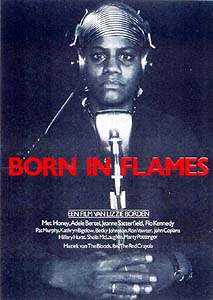 Born in Flames
by
Call Number: Motion Picture 16064Publication Date: 1983OCLC#: 77596729
Born in Flames
by
Call Number: Motion Picture 16064Publication Date: 1983OCLC#: 77596729
Set in an imaginary New York very much like the present, Lizzie Borden’s Born in Flames is a futuristic fable of feminist revolt. After a "peaceful" socialist revolution, unemployment, racism, and sexual harassment belie the utopian claims of the new government, on its tenth anniversary, women overcome divisions of race, class, and sexual orientation to form a guerrilla movement. Eventually, they take over control of the media and provide and alternative, unified voice. -
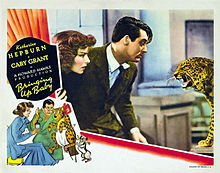 Bringing up Baby
by
Call Number: Motion Picture 16015Publication Date: 1938OCLC#: 8725412
Bringing up Baby
by
Call Number: Motion Picture 16015Publication Date: 1938OCLC#: 8725412
Susan, played by Katherine Hepburn, has a dog named George and a pet leopard, Baby meets a mild-mannered paleontologist, played by Cary Grant, who has just acquired the bone he needs to complete his dinosaur skeleton. George steals the bone; Baby is missing, and confusion reigns. Rapid-fire dialogue, zany story, wacky characterizations, plus the Howard Hawks style of direction makes this one of the most enduring examples of screwball comedy. -
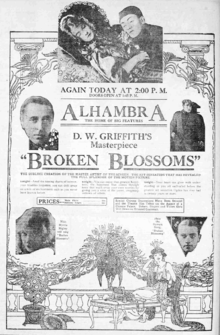 Broken Blossoms
by
Call Number: Motion Picture 16029Publication Date: 1919OCLC# 33070105
Broken Blossoms
by
Call Number: Motion Picture 16029Publication Date: 1919OCLC# 33070105
A highly sentimental tale about the relationship between a gentle Chinaman and an innocent waif in the Limehouse, district of London. The imaginary Limehouse, a gloomy fog-bound quarter, permeates the whole story with its melancholy atmosphere. The Chinese boy falls in love with the young girl, who lives in terror of her father, a boxer. After losing a match, the father returns home and beats his daughter to death. Upon this discovery, the Chinese boy kills the father and then himself. -
 Burning stable
by
Call Number: Motion Picture 16113Publication Date: 1896OCLC#: 864630888
Burning stable
by
Call Number: Motion Picture 16113Publication Date: 1896OCLC#: 864630888
Listed under title "Early Cinema Reel III". -
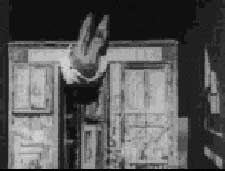 Chinese laundry
by
Call Number: Motion Picture 16113Publication Date: 1894OCLC#: 864630888
Chinese laundry
by
Call Number: Motion Picture 16113Publication Date: 1894OCLC#: 864630888
Listed under title "Early Cinema Reel III".
With Robetta and Doretta. -
 Citizen Kane
by
Call Number: Motion Picture 16008Publication Date: 1941OCLC#: 746920287
Citizen Kane
by
Call Number: Motion Picture 16008Publication Date: 1941OCLC#: 746920287
Welles directed, wrote, and starred in the film which is the story of Charles Foster Kane, a newspaper tycoon patterned in part on William Randolph Hearst. We get tantalizing glimpses into the life of Kane through the eyes of five people him and a March of Time newsreel. All we know is that he drives himself into voluntary exile; we never learn why. -
 City of Gold
by
Call Number: Motion Picture 16121Publication Date: 1957OCLC#: 123210741
City of Gold
by
Call Number: Motion Picture 16121Publication Date: 1957OCLC#: 123210741
Produced by the National Film Board of Canada, this short is a nostalgic look at the mining town of Dawson City during the Klondike Gold Rush. Vintage still photographs illustrate the creation and early life of the new town. Narrated by Dawson-born author Pierre Berton, the film shows thousands flocking to this frozen frontier to find their El Dorado. The contemporary Dawson City is contrasted to these earlier days when all the wealth of the river beds flowed through the town’s stores, taverns, and dance halls. -
 Il conformista (Conformist)
by
Call Number: Motion Picture 16062Publication Date: 1970OCLC#: 746938549
Il conformista (Conformist)
by
Call Number: Motion Picture 16062Publication Date: 1970OCLC#: 746938549
Based on the novel by Alberto Moravia, The Conformist follows a rising young Mussolini follower whom must assassinate his former professor, now in political exile, to demonstrate his loyalty to the Fascist State. Through an intricate mosaic structure and brilliantly staged sequences, director Bernardo Bertolucci equates the rise of Italian fascism with the psychosexual life of his protagonist for whom conformity becomes an obsession after a traumatic homosexual experience in his youth. -
 The Conversation
by
Call Number: Motion Picture 16053Publication Date: 1974OCLC#: 23664790
The Conversation
by
Call Number: Motion Picture 16053Publication Date: 1974OCLC#: 23664790
The film uses theme of eavesdropping and wiretapping, but focuses on the personal life of an electronic surveillance technician, rather that on his victims. Award winning director Francis Ford Coppola offers a sheer thriller, a psychological study, a social analysis and a political comment. The movie ruthlessly dissects wiretapper Harry-his vulnerabilities, his beliefs, his guilt’s, his romantic involvement’s-with a complex introspective characterization by Oscar-winner Gene Hackman. -
 Country Doctor
by
Call Number: Motion Picture 16112Publication Date: 1909OCLC#: 827797005
Country Doctor
by
Call Number: Motion Picture 16112Publication Date: 1909OCLC#: 827797005
Listed under title "Early Cinema Reel II"
14min. Made about a year after Griffith began directing, this is a melodrama about a dedicated doctor compelled to choose between saving the life of a neighbor’s child and that of his own beloved daughter. Griffith builds the suspense of this situation by cutting between the two households with ever-shorter shots. The most extraordinary element in this film, however, is the building of genuine feeling, not through the acting, which is still characterized by the gestures of the stage melodrama, but with camera movement and composition. An opening slow pan across a wide valley creates a pastoral mood, ending at the door of the doctor’s house from which the happy family emerges. A reverse pan across the same landscape that ends the film after the child’s death is elegiac. It was photographed in Greenwich, Connecticut. -
 Crocus
by
Call Number: Motion Picture 16082 reel 2Publication Date: 1971OCLC#: 823931189
Crocus
by
Call Number: Motion Picture 16082 reel 2Publication Date: 1971OCLC#: 823931189
Located under title "Animated shorts, 1957-1981", reel 2 -
 Da hong deng long gao gao gua (Raise the Red Lantern)
by
Call Number: Motion Picture 16116Publication Date: 1991OCLC#: 743337557
Da hong deng long gao gao gua (Raise the Red Lantern)
by
Call Number: Motion Picture 16116Publication Date: 1991OCLC#: 743337557
Mandarin/English Subtitles
Directed by Zhang Yimou. Sold into marriage in the 1920’s, 19 year Songlian finds she is merely the latest of her new lord’s four wives, each ensconced in her own courtyard, where each evening she waits to be chosen for the master’s sexual attentions-an honor signaled by the lighting of paper red lanterns by her door. Besides being reduced to an object in a collection, Songlian finds herself embroiled in a cutthroat power struggle with her three craftier more experienced “sisters”, all maneuvering to be first in the pecking order. Entangled in a silken web of intrigue, with traps lurking everywhere and treachery behind every smile, the increasingly paranoid Donglian stakes everything on a desperate gamble. -
 Dash through the clouds
by
Call Number: Motion Picture 16112Publication Date: 1912OCLC#: 827797005
Dash through the clouds
by
Call Number: Motion Picture 16112Publication Date: 1912OCLC#: 827797005
Located under title "Early Cinema Reel II".
12min. This farce comedy was directed by Sennett during his final year at Biograph before leaving to form his own company dedicated to the slapstick comedy. It exploits the current fascination with flying machines, still a very recent invention in 1912. Mabel Normand’s boyfriend is a tutti-frutti gum salesman. When he goes to a Mexican border town to sell his product, his attraction for women gets him into a difficult situation with the Mexican men. Meanwhile, Mabel’s interest has turned to a glamorous aviator and she has taken up flying. When her boyfriend calls for help, she stages a thrilling rescue in the aviator’s biplane. Mabel does her own flying, giving evidence of the risks expected of early actors and actresses. -
Daughter Rite by
Call Number: Motion Picture 16065Publication Date: 1978OCLC#: 317373096
Daughter Rite is the first Feminist film to examine intensively the issues posed by mother-daughter-sister relationships. Although it looks and sounds like cinema vérité, it is a fiction film based on interviews with more than 40 women. This patchwork document has broken not only the boundaries of orthodox form holding most feminist films in check, but also the taboos of subject matter restraining most women working within the avant-garde. Daughter Rite combines successfully traditional film forms-documentary, experimental and fiction. -
 Dead
by
Call Number: Motion Picture 16098Publication Date: 1960OCLC#: 52469579
Dead
by
Call Number: Motion Picture 16098Publication Date: 1960OCLC#: 52469579
This is the second film on the reel. Photographed in the Paris graveyard of Pere Lachaise, this film reflects upon the weight of history and the presence of the dead. -
 Devi (The Goddess)
by
Call Number: Motion Picture 16088Publication Date: 1960OCLC#: 8097389
Devi (The Goddess)
by
Call Number: Motion Picture 16088Publication Date: 1960OCLC#: 8097389
Bengali/English subtitles
An elderly landowner becomes convinced that his daughter-in-law is the incarnation of a Hindu goddess, to whom he is fanatically devoted. Religious rituals, embellished by moody, atmospheric photography, bring horror to Ray’s most intensely dramatic film. -
 Dewar's Scotch whiskey
Call Number: Motion Picture 16113Publication Date: 1897OCLC#: 864630888
Dewar's Scotch whiskey
Call Number: Motion Picture 16113Publication Date: 1897OCLC#: 864630888
Listed under title "Early Cinema Reel III".
The International Film Co. -
 Dickson Experimental Sound Film
by
Call Number: Motion Picture 16113Publication Date: 1895OCLC#: 864630888
Dickson Experimental Sound Film
by
Call Number: Motion Picture 16113Publication Date: 1895OCLC#: 864630888
Listed under title "Early Cinema Reel III".
Edison Co.l -
 Dog Star Man Part II
by
Call Number: Motion Picture 16096Publication Date: 1964OCLC#: 83828676
Dog Star Man Part II
by
Call Number: Motion Picture 16096Publication Date: 1964OCLC#: 83828676
This is the second film on the reel. The third movement of Brakhage’s masterwork, images of life, regeneration, spring and early morning. -
 Double Indemnity
by
Call Number: Motion Picture 16076Publication Date: 1942OCLC#: 746963662
Double Indemnity
by
Call Number: Motion Picture 16076Publication Date: 1942OCLC#: 746963662
Scripted by Raymond Chandler based on the James M. Cain novel of conspiracy and murder, Double Indemnity is the story of an insurance salesman who is conned into killing the husband of a beautiful client. Directed by Billy Wilder and starring Fred MacMurray, Barbara Stanwyck, and Edward G. Robinson, this film has been called one of the best “films noir” of the 1940’s. -
 The Draughtman's Contract
by
Call Number: Motion Picture 16090Publication Date: 1983OCLC#: 747046816
The Draughtman's Contract
by
Call Number: Motion Picture 16090Publication Date: 1983OCLC#: 747046816
In this beautifully filmed, 17th-century tale, and arrogant, young artist receives strange commissions from the mistress of an estate-in return for sexual favors. -
 Drowning By Numbers
by
Call Number: Motion Picture 16085Publication Date: 1988OCLC#: 750209318
Drowning By Numbers
by
Call Number: Motion Picture 16085Publication Date: 1988OCLC#: 750209318
With this film Peter Greenway returns to the playful punning, ludicrous lists, and quizzical conundrums of his earlier work: opening with a girl counting 100 stars, the plot then proceeds with these same numbers appearing roughly in sequence either in dialogue or in suitable bizarre images. Equally teasing is the film’s complex web of absurdly interlocking allusions to games, sex, and mortality. Drowning explores Modernist black comedy filled with arcane, archaic and apocryphal lore. -
Early Cinema Reel I: Edwin S. Porter byCall Number: Motion Picture 16111Publication Date: 1903-6OCLC#: 827791442
Life of an American Fireman. 1903. 6 min.
Rube and Mandy at Coney Island. 1903-13min.
The Train Wreckers. 1905-12min.
The Strenuous Life, or Antirace Suicide. 1906-5min.
Waiting at the Church. 1906-7min. -
Early Cinema Reel II byCall Number: Motion Picture 16112Publication Date: 1909OCLC#: 827797005
The Country Doctor: 1909-14min.
Her Choice. 1912-9min.
A Dash through the Clouds. Biography Co. 1912-12min.
A Vitagraph Romance. 1912-8min. -
Early Cinema Reel III: Films of the 1890's & Trick Films byCall Number: Motion Picture 16113Publication Date: 1890-00OCLC#: 864630888
Chinese Laundry. 1894.
The execution of Mary Queen of Scots. 1895.
Dickson Experimental Sound Film. 1895.
The Irwin-Rice Kiss. 1896.
Feeding The Doves. 1896
Morning Bath 1896.
Burning Stable. 1896.
The Black Diamond Express. 1896.
New York Street Scenes. 1897.
Fatima. 1897.
A Wringing Good Joke. 1899.
Dewar’s Scotch Whiskey. 1897.
An Impossible Voyage. 1904. Voyage a Travers L’impossible.
The “Teddy” Bears. 1907. -
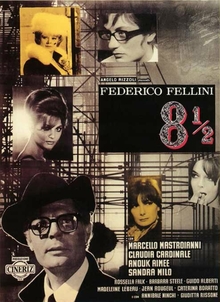 Eight and One Half (8 1/2)
by
Call Number: Motion Picture 16014Publication Date: 1963OCLC#: 23721891
Eight and One Half (8 1/2)
by
Call Number: Motion Picture 16014Publication Date: 1963OCLC#: 23721891
Italian/English subtitles
Guido, a 43 year old director is trying to sort out ideas about his new film. The problems are intensified by the arrival of both his mistress and his wife. Moving between reality, fantasy, and memory, he is crushed when he meets the vain actress who is to play the young, innocent girl, abandons the film, and dreams of suicide. In the final sequence, Guido leads everyone in his life--alive and dead, real and imaginary--in joyous procession around a circus ring. Academy award winner as Best Foreign Language Film.
Stars: Marcello Mastroianni, Anouk Aimee, Claudia Cardinale, and Sandra Milo.
Cinematographer: Gianni Di Venanzo. -
 L'Enfant sauvage (Wild Child)
by
Call Number: Motion Picture 16024Publication Date: 1970OCLC#: 78082582
L'Enfant sauvage (Wild Child)
by
Call Number: Motion Picture 16024Publication Date: 1970OCLC#: 78082582
French/English subtitles
It is based on a remarkable journal, the 1806 memoirs of a French physician, Dr. Jean Itard. Hearing of the discovery, in 1798 of a child living in the forest like an animal, Dr. Itard sends for him and takes upon himself the task of educating the boy. After some success the boy flees, but soon returns of his own accord. -
 Les enfants du paradis (Children of Paradise)
by
Call Number: Motion Picture 16042Publication Date: 1946OCLC#: 756496974
Les enfants du paradis (Children of Paradise)
by
Call Number: Motion Picture 16042Publication Date: 1946OCLC#: 756496974
Set in the theater district of Paris, this romantic epic holds a particularly revered place in the French Cinema. Directed by Marcel Carne, the project was begun in 1943, but was not completed until the end of the Occupation. Conceiving the film in the spirit of French novelists Hugo and Balzac, Carne centers on the loves and ambitions of a group of actors who eventually achieve fame, but never the happiness they so desperately seek. In the process of developing the story, Carne explores in depth the
relationship between life and art. Often shown in edited form, this complete print reveals an unqualified masterpiece in its full glory. -
 Every Man for Himself and God Against All
by
Call Number: Motion Picture 16061Publication Date: 1975OCLC#: 5589586
Every Man for Himself and God Against All
by
Call Number: Motion Picture 16061Publication Date: 1975OCLC#: 5589586
In the 1820’s a young man named Kaper Hauser appeared in a town in Germany. Unable to speak and barely able to stand, he was taken in by the town’s people and taught to speak, read and write. As mysteriously as he first appeared, he was murdered. -
 Execution of Mary Queen of Scots
by
Call Number: Motion Picture 16113Publication Date: 1895OCLC#: 864630888
Execution of Mary Queen of Scots
by
Call Number: Motion Picture 16113Publication Date: 1895OCLC#: 864630888
Listed under title "Early Cinema Reel III".
With Mr. R.L. Thomae as Mary. -
FatimaCall Number: Motion Picture 16113Publication Date: 1897OCLC#: 864630888
Listed under title "Early Cinema Reel III".
The International Film Co. -
 Feeding the doves
Call Number: Motion Picture 16113Publication Date: 1896OCLC#: 864630888
Feeding the doves
Call Number: Motion Picture 16113Publication Date: 1896OCLC#: 864630888
Listed under title "Early Cinema Reel III". -
 Furies
by
Call Number: Motion Picture 16082 reel 2Publication Date: 1975OCLC#: 823931189
Furies
by
Call Number: Motion Picture 16082 reel 2Publication Date: 1975OCLC#: 823931189
Located under title "Animated shorts, 1957-1981", reel 2 -
 Le Gai Savoir (Joy of Learning)
by
Call Number: Motion Picture 16055Publication Date: 1969OCLC#: 317357868
Le Gai Savoir (Joy of Learning)
by
Call Number: Motion Picture 16055Publication Date: 1969OCLC#: 317357868
French/English subtitles
Jean-Luc Godard made this feature film for French television. It is a Godardian exploration of language in all its permutations. He uses many film techniques, leaping visual metaphor upon metaphor to make his points. -
 Giulietta degli spiriti (Juliet of the Spirits)
by
Call Number: Motion Picture 16022Publication Date: 1965OCLC#: 476690947
Giulietta degli spiriti (Juliet of the Spirits)
by
Call Number: Motion Picture 16022Publication Date: 1965OCLC#: 476690947
Italian/English subtitles
When Giulitetta confirms her suspicions that her husband is having an affair, he denies it. As he leaves on a "business trip" Giuletta faces the fact that her entire existence has centered around her husband and that she must find another role in life. The screen becomes a canvas filled with vivid colors, stunning sets, and elaborate costumes in a lavish, overwhelming display. -
-
 The Gold Rush
by
Call Number: Motion Picture 16006Publication Date: 1925OCLC#: 37014799
The Gold Rush
by
Call Number: Motion Picture 16006Publication Date: 1925OCLC#: 37014799
Charlie Chaplin plays a pathetic little lone Prospector, who journeys to the Klondike hoping to discover gold and make his fortune. In Alaska, he shares a flimsy shack with Big Jim McKay, and falls in love with Georgia, a dance hall queen. -
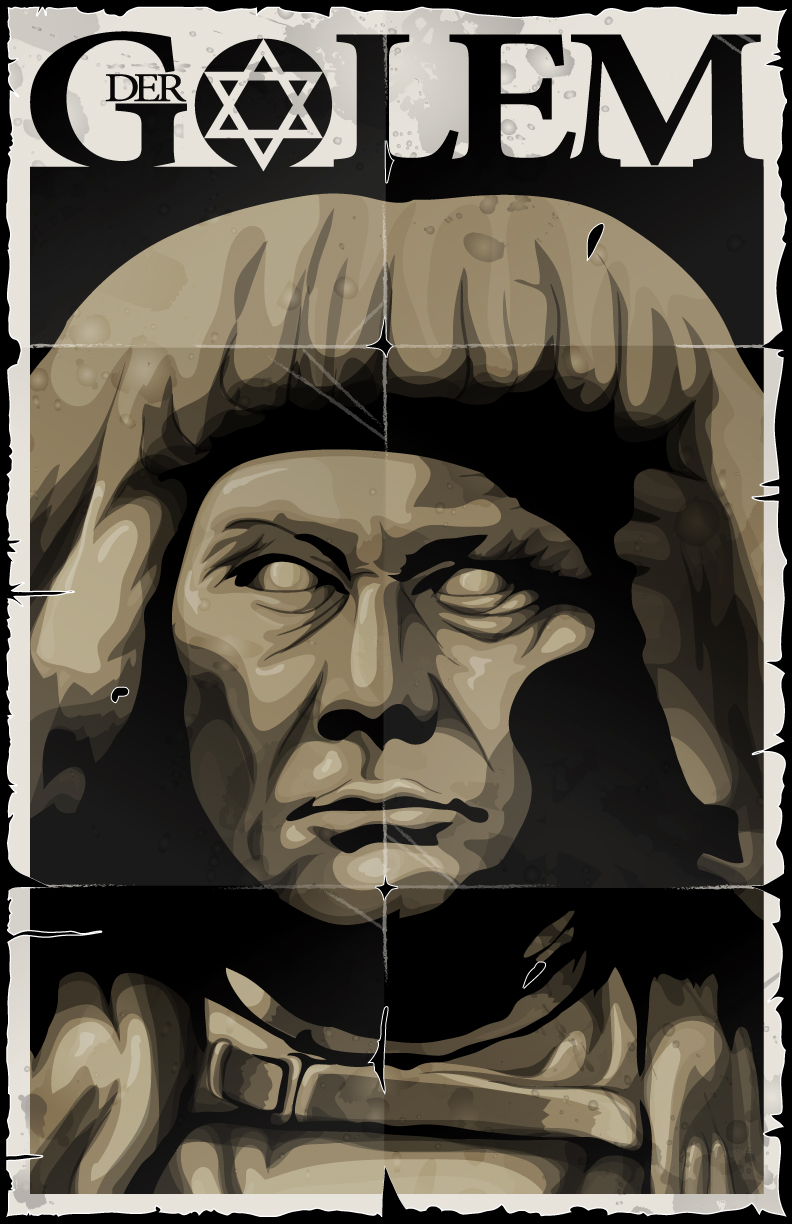 Golem
by
Call Number: Motion Picture 16016Publication Date: 1915OCLC#: 5711397
Golem
by
Call Number: Motion Picture 16016Publication Date: 1915OCLC#: 5711397
German/English subtitles
For this version, Wegener returned to the legend, setting the film in medieval Prague. Rabbi Loew gives life to the Golem who falls in love with the Rabbi’s daughter and brings fear to the emperor’s court. He is destroyed by an innocent child who offers him an apple and then removes the Star of David from his chest, sending him crashing to the ground. -
 Greed
by
Call Number: Motion Picture 16038Publication Date: 1924OCLC#: 77614373
Greed
by
Call Number: Motion Picture 16038Publication Date: 1924OCLC#: 77614373
Eric Von Stroheim’s masterwork, cut to a fraction of its original length, is noteworthy for vivid detail and realistic settings, including scenes shot on location in Death Valley. The film is based on Frank Norris’ McTeague. A former miner opens a dentist office in San Francisco. He soon meets and marries the daughter of German immigrants, who quickly shows her greedy nature. When the miner is exposed as a charlatan by his romantic rival, he is forced to give up his dental practice. He becomes a drunkard and a tramp, and winds up killing his wife. When he later encounters his rival in Death Valley, he kills him as well but remains bound to the corpse by handcuffs. -
Hard Passage byCall Number: Motion Picture 16082 reel 1Publication Date: 1981OCLC#: 823931189
Located under title "Animated shorts, 1957-1981", reel 1 -
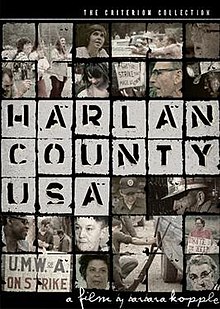 Harlan County, U.S.A.
by
Call Number: Motion Picture 16067Publication Date: 1977OCLC#: 423681922
Harlan County, U.S.A.
by
Call Number: Motion Picture 16067Publication Date: 1977OCLC#: 423681922
Portraying a classic century conflict between labor and between labor and management; Harlan Co. U.S.A. chronicles the efforts of 180 coal mining families to win a United Workers contract at the Brookside mine in Harlan County, Kentucky. The strike began in 1974 after the miners voted to join U.M.W. and Duke Power Company, parent company of the Brookside mine, refused to sign a standard U.M.W. contract. This was the first major confrontation in Harlan County since bloody union organizing battles in the 1930’s resulted in the deaths of five men. -
Her choice byCall Number: Motion Picture 16112Publication Date: 1912OCLC#: 827797005
Listed under title "Early Cinema Reel II"
9min. Vitagraph films are still rare enough to justify the inclusion of this incomplete and rather poor quality print, even though half of the film is missing. The film’s story is there in all its essentials: A wealthy schoolmistress anonymously gives scholarships to her two nieces to attend her exclusive girls’ school. One of them is a vain girl, who snubs her more humble cousin. The generous girl wins her reward when her aunt names her as heir to the school. -
 Hiroshima mon amour
by
Call Number: Motion Picture 16002Publication Date: 1959OCLC#: 4533657
Hiroshima mon amour
by
Call Number: Motion Picture 16002Publication Date: 1959OCLC#: 4533657
French/English subtitles
"When I’ve forgotten you, I’ll remember the night as a symbol without memory, the anguish of forgetting." This line is spoken by one of the lovers in Alain Resnais’ first feature film, a powerful portrait of two people, haunted by dark memories, seeking escape in a fleeting love affair. A French actress and a Japanese architect meet at Hiroshima and fall in love. Within 24 hours the actress must return to France and the brief but passionate encounter between two strangers must end. Resnais intercuts expressionistic shots of the two naked lovers, clinging to each other in bed, with newsreel footage of the bombing and its aftermath at Hiroshima. The architect still bears the scars of the tragedy and defeat of his people; his lover has equally painful memories of the War-her love for a German soldier and her humiliation at Nevers. -
 Hong gao liang (Red Sorghum)
by
Call Number: Motion Picture 16117Publication Date: 1987OCLC#: 71558393
Hong gao liang (Red Sorghum)
by
Call Number: Motion Picture 16117Publication Date: 1987OCLC#: 71558393
Mandarin/English subtitles
Winner of the 1988 Golden Bear award at Berlin, this gorgeous fable begins as a romantic comedy telling of a nervous young bride’s arrival at a remote provincial winery, her wooing by a clumsily passionate peasant, her abduction by a notorious chieftain, and her successful assumption of the family business upon the murder of her aged husband. Then surprisingly but effectively, the widow’s story turns into a heroic and harrowing drama dealing with enemy brutality and partisan resistance fighting during Japan’s occupation of China. -
 I...Dreaming
by
Call Number: Motion Picture 16094Publication Date: 1988OCLC#: 823929886
I...Dreaming
by
Call Number: Motion Picture 16094Publication Date: 1988OCLC#: 823929886
This is a setting-to-film of a ‘collage’ of Stephen Foster phrases by composer Joel Haertling. The recurring musical themes and Melancholia of Foster refer to ‘loss of love’ in the popular torch song mode, but the film envisions a re-awakening of such senses-of-love as children know, and posits (along a line of words scratched over picture) the whole psychology of waiting. -
Illusions by
Call Number: Motion Picture 16103Publication Date: 1982OCLC#: 756509297
The time is 1942, a year after Pearl Harbor, the place is National Studios, a fictitious Hollywood motion picture studio. The story is about Mignon Dupree, a black woman studio executive who appears to be white and Ester Jeeter, a black woman who is the singing voice for a white Hollywood star. Forced to come to grips with a society that perpetuates false images as status quo. Illusions follow a Mignon’s dilemma, Ester’s struggle and the use of cinema in wartime Hollywood: three illusions in conflict with reality. -
 L’Immortelle (Immortal)
by
Call Number: Motion Picture 16040Publication Date: 1962OCLC#: 823753699
L’Immortelle (Immortal)
by
Call Number: Motion Picture 16040Publication Date: 1962OCLC#: 823753699
French/English subtitles
A beautiful, ageless woman, identified only as "She", has a brief affair with a French professor. She disappears in Istanbul and he follows her through bazaars and winding alleys. His search becomes and enigmatic, compulsive journey and finally leads to his own destruction. Through the repetition of images, flashbacks and flashes forward, Robbe-Grillet tries to subjectively portray emotions--love, loss, fear, and suspicion--mixing what is true with what might be true and what might have been. -
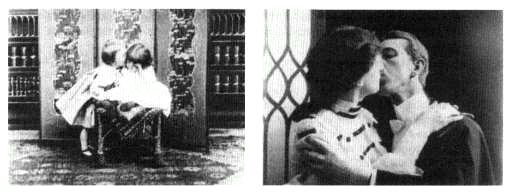 Irwin-Rice Kiss
by
Call Number: Motion Picture 16113Publication Date: 1896OCLC#: 864630888
Irwin-Rice Kiss
by
Call Number: Motion Picture 16113Publication Date: 1896OCLC#: 864630888
Listed under title "Early Cinema Reel III".
Edison Co. From the Play the Widow Jones. With May Irwin and John C. Rice. -
 Ivan Grozniy (Ivan the Terrible, Part I)
by
Call Number: Motion Picture 16004Publication Date: 1944OCLC#: 33401495
Ivan Grozniy (Ivan the Terrible, Part I)
by
Call Number: Motion Picture 16004Publication Date: 1944OCLC#: 33401495
Russian/English subtitles
In 1942, Sergei Eisenstein, at the height of the conflict with Germany, began what was supposed to be three-part epic biography of Czar Ivan IV. His goal was to offer a comprehensive vision of Ivan... "concealing nothing...detracting nothing from the splendid image of the past." Part I opens with Ivan’s coronation, an event which aroused the indignation of the foreign envoys and the boyars. Ivan announces his intention to unify all Russian lands seized by foreign powers. After a successful military campaign, he falls ill and his aunt poisons Ivan’s wife Anastasia, so that her son can become heir to the
throne. Ivan, learning of Anastasia’s murder vows to destroy all his enemies and rallies massive support against the boyars. -
 Ivan Grozniy (Ivan the Terrible, Part II)
by
Call Number: Motion Picture 16005Publication Date: 1946OCLC#: 42485162
Ivan Grozniy (Ivan the Terrible, Part II)
by
Call Number: Motion Picture 16005Publication Date: 1946OCLC#: 42485162
Russian/English subtitles
Continues Eisenstein’s epic of the 16th century Czar Ivan IV. Filmed East of the Ural Mountains while Russia was still fighting German invaders, this tragic portrayal of a man’s thwarted efforts to unify his country is especially provocative. Part II opens with selected scenes from Part I, summarizing events leading to Ivan’s return to Moscow weary of war and internal strife. Charges and counter charges lead Ivan to become what he has been unjustly called, Ivan the Terrible. Learning of his aunt’s plot to have him murdered, he devises a scheme which results in her accidentally slaying her own son. The banquet scene during which the slaying occurs, was filmed in color and remains the only color sequence of
Eisenstein’s career. Part II was banned by the Soviet government until 1958, and Part III was never completed due to Eisenstein’s death. -
 Jeanne Dielman
by
Call Number: Motion Picture 16080Publication Date: 1975OCLC#: 827347953
Jeanne Dielman
by
Call Number: Motion Picture 16080Publication Date: 1975OCLC#: 827347953
French/English subtitles
Jeanne Dielman is an underground epic that has achieved a popular reputation as an experimental cult classic. It is the story of three days in the life of a Belgian housewife and part-time prostitute who is obsessed with perfectly executed and superbly ordered ritual. One day, when the ritual is disrupted at its core, it yields chaotic results that are terrifying and sinister. -
 Le Jour Se Leve (Daybreak)
by
Call Number: Motion Picture 16079Publication Date: 1939OCLC#: 79019125
Le Jour Se Leve (Daybreak)
by
Call Number: Motion Picture 16079Publication Date: 1939OCLC#: 79019125
French/English subtitles
Told in three recollected sequences, it conveys the intense drama, irony, and nostalgia of urban life. Jean Gabin gives a tour de force performance as Francois, a tormented man becomes a murderer. -
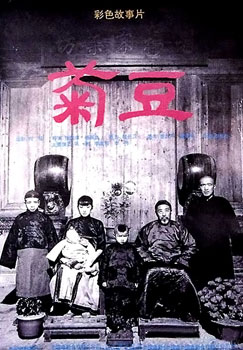 Ju Dou
by
Call Number: Motion Picture 16115Publication Date: 1990OCLC#: 148229056
Ju Dou
by
Call Number: Motion Picture 16115Publication Date: 1990OCLC#: 148229056
Mandarin/English subtitles
This tautly plotted exquisitely filmed fable of passion and retribution is the story of Jinshan, the miserly, impotent owner of a rural cloth-dyeing mill who acquires a young, ripe -bodied Ju Dou, whom he abuses atrociously, but when his downtrodden foster-son Tianging falls in love with Ju Dou, she seduces him and gives birth to a son. Ostensibly the master’s but actually Tianging’s. In the first of the series of ironic reversals, the ties of convection prove stronger than those of biology and the fierce, silent boy bonds with Jinshan and turns against his natural parents becoming a remorseless instrument of social justice. -
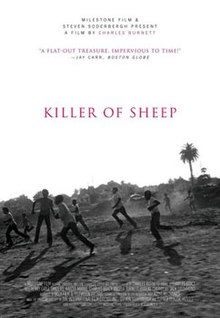 Killer of Sheep
by
Call Number: Motion Picture 16104Publication Date: 1978OCLC#: 823930920
Killer of Sheep
by
Call Number: Motion Picture 16104Publication Date: 1978OCLC#: 823930920
In a moving portrait of Stan, a young black man employed in a Los Angeles slaughterhouse. His grueling work, gutting and cleaning the carcasses of dead sheep, infects his whole life, including his relationships with his wife, children, and friends. Burnett unfolds Stan’s story with compassion and honesty. His film hauntingly evokes the physical details and the bittersweet emotions of working-class life. The extraordinary soundtrack, made up of a wide range of musical styles, together with the film’s
mood and powerful vignettes dramatically suggest a vast social and historical experience beyond the individual hardship and tragedy of one person. -
 Kindering
by
Call Number: Motion Picture 16095Publication Date: 1987OCLC#: 842963613
Kindering
by
Call Number: Motion Picture 16095Publication Date: 1987OCLC#: 842963613
This film presents the voice of a child play-singing in relation to full orchestral ‘takes’ of the times and visually juxtaposed with children -at-play (my grandchildren Iona and Quay Barek) in Americana backyard. They are seen, as in dream, to be already caught-up-in yet absolutely distinct-from the rituals of adulthood. The visuals were photographed and edited to the music of Architect's Office performance A0124 by Tevor and Joel Haerting and Doug Stickler. -
 Kumonosu-jo (Throne of Blood)
by
Call Number: Motion Picture 16118Publication Date: 1957OCLC#: 29599356
Kumonosu-jo (Throne of Blood)
by
Call Number: Motion Picture 16118Publication Date: 1957OCLC#: 29599356
Japanese/English subtitles
Throne of Blood is a Graphic, powerful adaptation of Macbeth in a samurai setting. This film contains a gripping finale, with Taketoki Washizu attacked by arrows. -
 Life of an American fireman
by
Call Number: Motion Picture 16111Publication Date: 1903OCLC#: 827791442
Life of an American fireman
by
Call Number: Motion Picture 16111Publication Date: 1903OCLC#: 827791442
Located under title "Early Cinema Reel 1: Edwin S. Porter".
6 min.
The film is restored from an original print recently discovered by the American Film Institute Archives Program and should finally resolve the perplexing problem of its various versions and as film histories have given him credit, will expose Porter as the leading proponent of the “non-continuous” narrative style of much of early cinema. -
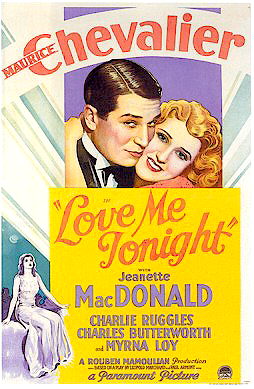 Love Me Tonight
by
Call Number: Motion Picture 16077Publication Date: 1932OCLC#: 74459525
Love Me Tonight
by
Call Number: Motion Picture 16077Publication Date: 1932OCLC#: 74459525
Love Me Tonight is musical fantasy about the story book romance of a poor tailor and a rich countess. This delightful interweaving of songs, music, and story was done in an imaginative, fresh, and structurally sound manner by Mamoulian. -
 Lucia
by
Call Number: Motion Picture 16056Publication Date: 1969OCLC#: 22160695
Lucia
by
Call Number: Motion Picture 16056Publication Date: 1969OCLC#: 22160695
Spanish/English subtitles
Lucia dramatizes three separate periods in Cuba’s struggle for liberation, and the participation of Cuban women in that fight. In 1895, Lucia is embroiled in a tale of love and betrayal during Cuba’s war for independence from Span. In 1933, Lucia leaves her middle-class family and is involved in the overthrow of the Cuban dictator, Machado. In the 1960’s, Lucia learns to read and write during Cuba’s literacy campaign, and as a newlywed confronts her husband’s "macho" attitudes. Each episode is filmed in visual style which symbolizes the spirit of each historical era. -
 The Magnificent Ambersons
by
Call Number: Motion Picture 16009Publication Date: 1942OCLC#: 71359934
The Magnificent Ambersons
by
Call Number: Motion Picture 16009Publication Date: 1942OCLC#: 71359934
Orson Welles’ vivid imagination turns this film into a classic of cinematic invention. He utilized the stationary camera and long tracking shots in this story of the declining magnificence of the Ambersons’ dynasty. Welles’ depicted the individual who was forced to change to meet the new socio-economic world head-on. Greed, arrogance, and ruthlessness are traded for fear, remorse, and tragedy. -
 Make me psychic
by
Call Number: Motion Picture 16082 reel 2Publication Date: 1978OCLC#: 823931189
Make me psychic
by
Call Number: Motion Picture 16082 reel 2Publication Date: 1978OCLC#: 823931189
Located under title "Animated shorts, 1957-1981", reel 2 -
 Malenkaya Vera (Little Vera)
by
Call Number: Motion Picture 16108Publication Date: 1988OCLC#: 823931136
Malenkaya Vera (Little Vera)
by
Call Number: Motion Picture 16108Publication Date: 1988OCLC#: 823931136
Russian/English subtitles
The first Soviet film to show sex on screen and realistically depict life in the modern working class, Little Vera, attracted worldwide media attention and catapulted actress Natalia Negoda to stardom. Vera is a teenager solely interested in frequenting dance halls with her friends, but when one of her flings turns serious, she finds herself with a live-in boyfriend and her life in shambles. Little Vera manages to
entertain while revealing the personal and bureaucratic problems of the last days of the U.S.S.R. Also starring Andrei Sokolov and Yuri Nazorov. -
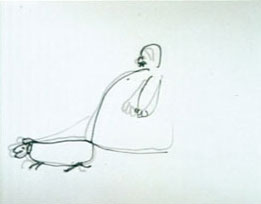 A Man and his dog out for air
by
Call Number: Motion picture 16082 reel 1Publication Date: 1957OCLC#: 823931189
A Man and his dog out for air
by
Call Number: Motion picture 16082 reel 1Publication Date: 1957OCLC#: 823931189
Located under title "Animated shorts, 1957-1981", reel 1 -
 Man with a Movie Camera
by
Call Number: Motion Picture 16034Publication Date: 1929OCLC#: 33348290
Man with a Movie Camera
by
Call Number: Motion Picture 16034Publication Date: 1929OCLC#: 33348290
A film documenting Russian life in 1929. It is a complex, experimental film, which demonstrates Vertov’s "Kino Eye" theory in which the lens of the camera is identified with the human eye. The "hero" of the film is actually the camera which is shown throughout, including a trick sequence where the camera appears to be walking about without human assistance. -
 Meet Me in St. Louis
by
Call Number: Motion PicturePublication Date: 1944OCLC#: 18786229
Meet Me in St. Louis
by
Call Number: Motion PicturePublication Date: 1944OCLC#: 18786229
Minnelli’s first color film is a captivating evocation of family life in St. Louis at the time of the 1903 World’s Fair. Wonderful music sets the mood for this charming tale. -
 Memorias del subdesarrollo (Memories of Underdevelopment)
by
Call Number: Motion Picture 16109Publication Date: 1968OCLC#: 823931159
Memorias del subdesarrollo (Memories of Underdevelopment)
by
Call Number: Motion Picture 16109Publication Date: 1968OCLC#: 823931159
Spanish/English subtitles
As the first film from post-revolutionary Cuba to be released in the U.S., Memories of Underdevelopment had a widespread impact unequaled in the history of the Third World Cinema. Set in the early 1960’s the film centers on a Europeanized Cuban intellectual, who is too idealistic to leave for Miami, but to decadent to fit into the new society. A critique of revolutionary society (the "underdevelopment" extends to many levels), a critique of that critique, and a remarkable demonstration that artistic subtlety, political commitment and entertainment are not incompatible. Based on a novel by Con Sergio Corrieri. -
 Menilmontant
by
Call Number: Motion Picture 16048Publication Date: 1926OCLC#: 71359997
Menilmontant
by
Call Number: Motion Picture 16048Publication Date: 1926OCLC#: 71359997
This is a sensitive and exquisitely made silent film about two sisters whose lives are touched by almost unrelenting tragedy. One is seduced by a fickle youth and abandoned while pregnant; the other drifts into prostitution. Their ultimate reunion reaffirms their faith in life and restores their will to live. Wonderfully acted and directed, and evocatively shot on location in Paris, not so much as a melodrama as a precursor to neo-realism. -
 Meshes of the Afternoon
by
Call Number: Motion Picture 16047Publication Date: 1943OCLC#: 823863591
Meshes of the Afternoon
by
Call Number: Motion Picture 16047Publication Date: 1943OCLC#: 823863591
The study of a split personality, and the first film directed by Maya Deren, who also plays the lead character. An immigrant from Russia, Deren was a pioneering American experimentalist, who became an expert on the “personal” film... “in which the artist crosses the threshold from that which already exists into the void where he/she creates.... -
 Morning bath
Call Number: Motion Picture 16113Publication Date: 1896OCLC#: 864630888
Morning bath
Call Number: Motion Picture 16113Publication Date: 1896OCLC#: 864630888
Listed under title "Early Cinema Reel III". -
 Mother
by
Call Number: Motion Picture 16017Publication Date: 1926OCLC#: 4610227
Mother
by
Call Number: Motion Picture 16017Publication Date: 1926OCLC#: 4610227
Mother is probably V.I. Pudovkins’s greatest work. It is the best illustration of his mastery of film technique, as well as a moving drama of revolution. Mother depicts an aspect of the abortive 1905 revolt. Concentrating on individual injustice during Tzarist rule, Pudovkin illustrates, not in abstract heroes, but specific human problems. The father is a drunk, a reactionary, and a strike-breaker; the mother is patient and long-suffering; and the son, Pavel, symbolizes the new Communist Youth. -
 Mothlight
by
Call Number: Motion Picture 16096Publication Date: 1963OCLC#: 83828676
Mothlight
by
Call Number: Motion Picture 16096Publication Date: 1963OCLC#: 83828676
A film collage of moth wings and plant life, literally pasted upon the filmstrip, showing the fugue-like movements of a moth in flight. Most of this film really concerns the persistence of the essential form, image, and motion of being. -
 Narayama bushi-ko (Ballad of Narayama)
by
Call Number: Motion Picture 16084Publication Date: 1983OCLC#: 746161066
Narayama bushi-ko (Ballad of Narayama)
by
Call Number: Motion Picture 16084Publication Date: 1983OCLC#: 746161066
Deep in an isolated, impoverished village, the elderly are customarily abandoned on a mountaintop to
meet the Gods of Narayama upon reaching the age of seventy. Orin, a Matriarch whose time has come, must make plans to assure the survival of her family as stolen crops, and newborn additions threaten their very existence. Nayrayama has established Shohei Imamura among the greatest of Directors. Winner of the Grand Prize at the Cannes Film Festival. -
 Nashville
by
Call Number: Motion Picture 16120Publication Date: 1975OCLC#: 746079895
Nashville
by
Call Number: Motion Picture 16120Publication Date: 1975OCLC#: 746079895
Novelistic off beat drama, offers insightful panorama country music capital, and by extension America as a whole. This essential 1970 classic appeals to fans of social critic. -
New York street scenesCall Number: Motion Picture 16113Publication Date: 1897OCLC#: 864630888
Listed under title "Early Cinema Reel III". -
 Night Music
by
Call Number: Motion Picture 16095Publication Date: 1986OCLC#: 842963613
Night Music
by
Call Number: Motion Picture 16095Publication Date: 1986OCLC#: 842963613
This film (originally painted on IMAX film stock) attempts to capture the beauty of sadness, as the eyes have it when closed in mediation on sorrow. -
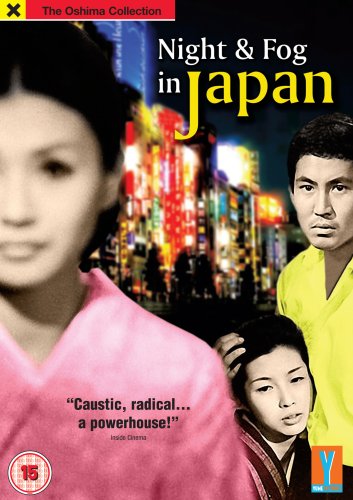 Nihon no roru to kiri (Night and Fog in Japan)
by
Call Number: Motion Picture 16073Publication Date: 1960OCLC#: 222397196
Nihon no roru to kiri (Night and Fog in Japan)
by
Call Number: Motion Picture 16073Publication Date: 1960OCLC#: 222397196
Japanese/English subtitles
The wedding celebration of two young political activists becomes the catharsis for a series of political confrontations. Show with a dazzling style that combines flashbacks, off-screen scenarios, blackouts, and balletic tracking shots. This is one of Nagisa Oshima’s most ingenious and radical films. It was withdrawn in Japan as “Politically Inflammatory” three days after its initial release. -
 North by Northwest
by
Call Number: Motion Picture 16083Publication Date: 1959OCLC#: 756517888
North by Northwest
by
Call Number: Motion Picture 16083Publication Date: 1959OCLC#: 756517888
This suspense thriller uses the streets of New York and Chicago, the U.N. building, Grand Central Station, the Mt. Rushmore national monument, and a barren Indiana prairie as dazzling backgrounds for this bizarre and very delightful intrigue. When an unsuspecting Madison Avenue advertising man is mistaken for a Central Intelligence man, his life is in danger. Foreign agents try to kill him in ingenious ways and when he eludes them, a gorgeous, double-dealing blonde lures him into her train compartment. She “kills” him to impress James Mason, and art dealer who deals in stolen microfilm. In a superb
Hitchcockian finale, they escape together after an exciting chase over the Presidential stone faces of Mt. Rushmore. -
 Nosferatu: Phantom der Nacht (Nosferatu, the Vampyre)
by
Call Number: Motion Picture 16105Publication Date: 1979OCLC#: 756644697
Nosferatu: Phantom der Nacht (Nosferatu, the Vampyre)
by
Call Number: Motion Picture 16105Publication Date: 1979OCLC#: 756644697
German/English subtitles
Werner Herzog’s adaptation of Dracula is literate, faithful, and visually stunning. Klaus Kinski is magnificent as the deadly, driven vampire who is almost pathetic in his need. -
 On the Waterfront
by
Call Number: Motion Picture 16054Publication Date: 1954OCLC#: 7562824
On the Waterfront
by
Call Number: Motion Picture 16054Publication Date: 1954OCLC#: 7562824
Winner of eight Academy Awards, this hard-hitting film is about corruption in the Longshoreman’s Union. It tackles complex social, political and personal issues without losing any of its dramatic force. It has become a lasting influence on American culture. -
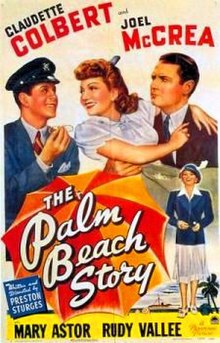 Palm Beach Story
by
Call Number: Motion Picture 16078Publication Date: 1942OCLC#: 756648126
Palm Beach Story
by
Call Number: Motion Picture 16078Publication Date: 1942OCLC#: 756648126
This “screwball” comedy was directed by Preston Sturges. The story is centered around the debated marriage arrangement between Gerry and Tom Jeffers. Gerry leaves her husband in order to pursue a marriage between herself and a millionaire in order to further Tom’s career. The ensuing calamity has J.B. Hackensacker III, one of the richest men in the world, and his sister, amorously pursuing Gerry and Tom, who are posing as sister and brother. -
 La Passion de Jeanne d'Arc (The Passion of Joan of Arc)
by
Call Number: Motion Picture 16012Publication Date: 1928OCLC#: 37497601
La Passion de Jeanne d'Arc (The Passion of Joan of Arc)
by
Call Number: Motion Picture 16012Publication Date: 1928OCLC#: 37497601
This film depicts the events of the final five months in Joan’s life compressed into a drama apparently taking place in one day. Director Carl Dreyer portrays the interrogations as Joan’s trial, her imprisonment, execution at the stake, and the stake, and the massacre of the crowd by the English. Above all, Dreyer stresses the very human, emotional anguish which most often accompany spiritual faith in a world governed by hypocrites and compromises. It is this anguish which leads Joan to abjure; and it is faith which leads her to withdraw her abjuration, although it means her death. -
 Pencil Bookings
by
Call Number: Motion picture 16082 reel 1Publication Date: 1978OCLC#: 823931189
Pencil Bookings
by
Call Number: Motion picture 16082 reel 1Publication Date: 1978OCLC#: 823931189
Located under title "Animated shorts, 1957-1981", reel 1. -
 Persona
by
Call Number: Motion Picture 16045Publication Date: 1967OCLC#: 7645823
Persona
by
Call Number: Motion Picture 16045Publication Date: 1967OCLC#: 7645823
Persona expresses a sense of visual, moral, and spiritual ambiguity with an intensity and completeness previously unseen in Bergman’s work. The plot concerns Elizabeth, a renowned stage actress, who suffers a nervous breakdown and cannot speak. She is sent to an isolated seashore where she is cared for by a nurse-companion, Alma. An odd mechanism of mutual identification develops, and the actress comes to rely on Alma for moral sustenance, a need that is almost physical. -
 Pickpocket
by
Call Number: Motion Picture 16046Publication Date: 1959OCLC#: 823862339
Pickpocket
by
Call Number: Motion Picture 16046Publication Date: 1959OCLC#: 823862339
The subject is the agitation and transformation of a soul. Like a Dostoyevsky novel, Pickpocket probes the conscience of a criminal and the question of criminal compulsions. -
 Playtime
by
Call Number: Motion Picture 16023Publication Date: 1967OCLC#: 43997160
Playtime
by
Call Number: Motion Picture 16023Publication Date: 1967OCLC#: 43997160
French/English dialogue; no subtitles
Playtime reflects the confusion and mixed enjoyment of a group of international tourists who arrive by jet planes at Orly airport. They are dispatched to Paris, a city so ultra-modern that is hardly differs from other cities throughout the world. A science fair preempts the traditional visit to the Louvre or the Eiffel Tower; the quaint bistros have been supplanted by snack bars and nightclubs. Mr. Hulot the innocent-at-large in his native Paris, shares the tourists’ experience as he bumbles about with his unique brand of curiosity. -
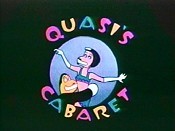 Quasi's Cabaret Trailer
by
Call Number: Motion Picture 16082 reel 2Publication Date: 1980OCLC#: 823931189
Quasi's Cabaret Trailer
by
Call Number: Motion Picture 16082 reel 2Publication Date: 1980OCLC#: 823931189
Located under title "Animated shorts, 1957-1981", reel 2 -
 Rear Window
by
Call Number: Motion Picture 16075Publication Date: 1954OCLC#: 756659082
Rear Window
by
Call Number: Motion Picture 16075Publication Date: 1954OCLC#: 756659082
Rear Window is a film about a news photographer with a broken leg who passes time by watching neighbors from his window. Equipped with a telescopic lens, he notices the strange behavior of one neighbor. Armed with a few facts and a great deal of ingenuity, he eventually concludes that his neighbor has killed his wife. His enforced immobility is transformed into a brilliant exercise in suspense. -
 Roma città aperta (Open City)
by
Call Number: Motion Picture 16031Publication Date: 1946OCLC#: 80345277
Roma città aperta (Open City)
by
Call Number: Motion Picture 16031Publication Date: 1946OCLC#: 80345277
Italian/English subtitles
This film was planned in secret by Roberto Rossellini and his colleagues while the Nazis still occupied Rome, Italy. It revolves around a group of resistance fighters and a local priest. It contains strong melodramatic elements, such as broken marriages, prostitution, drug addiction, and Nazi occupation. Grand Prize Winner at Cannes and the Venice Film Festival, and starring Anna Magnani, Open City is one of the most important of all Italian Neo Realist films. -
 Rube and Mandy at Coney Island
by
Call Number: Motion Picture 16111Publication Date: 1903OCLC#: 827791442
Rube and Mandy at Coney Island
by
Call Number: Motion Picture 16111Publication Date: 1903OCLC#: 827791442
Located under title "Early Cinema Reel 1: Edwin S. Porter".
13min. This is a comedy in which two leading vaudeville performers play country bumpkins taking in the wonders of Coney Island in 1903. It is a series of comic episodes connected by a common motif rather than an integrated narrative. It demonstrates how early cinema employed close views as a code to the main structure of a film, with its final shot of Rube and Mandy enjoying hot dogs. -
 Sauve qui peut (Every Man for Himself)
by
Call Number: Motion Picture 16081Publication Date: 1980OCLC#: 173697884
Sauve qui peut (Every Man for Himself)
by
Call Number: Motion Picture 16081Publication Date: 1980OCLC#: 173697884
French/English subtitles
Continuously and inherently experimental, Every Man For Himself is the intersecting story of a TV Director, his girlfriend, and a young prostitute. It is a mediation on modern life, infused with perverse wit, explicit eroticism, and startling beauty.
Starring Isabelle Huppert and Natalie Baye. -
 Scorpio Rising
by
Call Number: Motion Picture 16050Publication Date: 1963OCLC#: 43997110
Scorpio Rising
by
Call Number: Motion Picture 16050Publication Date: 1963OCLC#: 43997110
This movie is considered one of the best underground films. It is a study, lyrical in form and in the manner of its execution, of a group of black-leather-jacketed young men, whose chief object of worship is the motorcycle. These young men are the priests of a cult dedicated not to a shining, wheeled god, but to death---that sudden death which James Dean and other apostolic predecessors have already embraced. -
 She's Gotta Have It
by
Call Number: Motion Picture 16114Publication Date: 1986OCLC#: 71357570
She's Gotta Have It
by
Call Number: Motion Picture 16114Publication Date: 1986OCLC#: 71357570
Perhaps the most striking debut film of the last twenty years. Lee’s first feature is sexy, bawdy, freewheeling and electric; an exuberant collage of staccato of montages, still frames and confidential asides to the camera. At the center of the vortex is one of Lee’s most impressive creations. Nola Darling, a free-spirited woman who shares her bed with three men yet is too independent to fall for the vanities of masculine behavior. -
 Singin' in the Rain
by
Call Number: Motion Picture 16063Publication Date: 1952OCLC#: 18845540.
Singin' in the Rain
by
Call Number: Motion Picture 16063Publication Date: 1952OCLC#: 18845540.
This is undoubtedly one of the best musicals of the fifties, matching An American in Paris in its pace, rhythmic structure, and memorable songs , and On the Town in its smoothly constructed and witty script by Adolph Green and Betty Comden. Its background of the Roaring Twenties and satire on Hollywood during the introduction of sound add much to the film’s appeal. The imaginative choreography includes several tributes to Busby Berkeley and a striking semiabstract ballet by Kelly and Cyd Charisse. -
 Le souffle au cœur (Murmur of the Heart)
by
Call Number: Motion Picture 16032Publication Date: 1971OCLC#: 823745946
Le souffle au cœur (Murmur of the Heart)
by
Call Number: Motion Picture 16032Publication Date: 1971OCLC#: 823745946
Set in Dijon, France, 1954, the film tells the story of a boy passing through adolescence. This comedy-drama pierces the moral facade of an upper-class French family during a period of shifting values, when France was fighting a lost cause in Indo-China. Although the theme is essentially incest, it has been handled with delicacy, sophistication, and humor. -
 La Souriante Madame Beudet (The Smiling Madame Beudet)
by
Call Number: Motion Picture 16102Publication Date: 1922OCLC#: 9233043
La Souriante Madame Beudet (The Smiling Madame Beudet)
by
Call Number: Motion Picture 16102Publication Date: 1922OCLC#: 9233043
The Smiling Madame Beudet is the story of an intelligent woman trapped in a loveless marriage. Her husband is used to playing a stupid practical joke in which he puts an empty revolver to his head and threatens to shoot himself. One day, while the husband is away, she puts bullets in the revolver. However, she is stricken with remorse and tries to retrieve the bullets the next morning. Her husband gets to the revolver first only this time he points the revolver at her. -
 Stagecoach
by
Call Number: Motion Picture 16020Publication Date: 1939OCLC#: 148118655
Stagecoach
by
Call Number: Motion Picture 16020Publication Date: 1939OCLC#: 148118655
A classic among Westerns, this film relates the saga of a westbound stagecoach with eight passengers traveling through dangerous Indian territory. The interaction between the eight is delineated with great depth and compassion, aboard a stagecoach which serves as a metaphor for life’s journey. Stagecoach was the first Western to introduce moral dilemmas and character studies into an action-oriented plot. It reveals director John Ford’s unfailing sense of human conflict and dignity in one of his most compelling, memorable works. -
 Potomok Chingiskhana (Storm Over Asia)
by
Call Number: Motion Picture 16018Publication Date: 1928OCLC#: 78175036
Potomok Chingiskhana (Storm Over Asia)
by
Call Number: Motion Picture 16018Publication Date: 1928OCLC#: 78175036
The last silent film by Vsevolod I. Pudovkin, is one of his finest achievements. It tells of the Mongolian uprising against the British occupation forces during the Civil War period. Pudovkin focuses on Bair a young Mongolian hunter who brings a rare silver-fox skin to market. There, he is cheated out of it by an English fur trader protected by the British forces. They use Bair as one of the reasons for the intervention. Finally, Bair’s rage breaks out, and the film ends in a symbolic “storm” as the Mongolian army sweeps away the interventionists. -
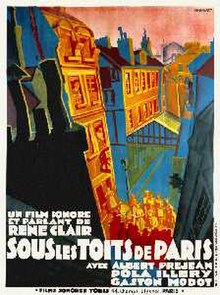 Sous les toits de Paris (Under the Roofs of Paris)
by
Call Number: Motion Picture 16030Publication Date: 1930OCLC#: 317028718
Sous les toits de Paris (Under the Roofs of Paris)
by
Call Number: Motion Picture 16030Publication Date: 1930OCLC#: 317028718
A street singer, Albert, has a mistress, Pola, a pretty Romanian girl who also flirts with his best friend, Louis. While Albert is in jail for a theft he did not commit, Louis and Pola become lovers. When he is released, Albert and Louis quarrel over the girls, but when Albert sees that Pola really loves Louis, he abandons his claim and the three remain friends. The title song is passed from one to another like a musical toast and comforts Albert in the melancholy moments when he loses the girl. Under the Roofs of Paris is a film portrait of the ordinary Parisian, yet features amazingly ingenious shot construction and suggests that narration can cross the boundaries of both the directly visual and verbal narrative into a space-in-between the two which is deliberate and artistically articulated. -
 Strenuous life, or antirace suicide
by
Call Number: Motion Picture 16111Publication Date: 1906OCLC#: 827791442
Strenuous life, or antirace suicide
by
Call Number: Motion Picture 16111Publication Date: 1906OCLC#: 827791442
Listed under title "Early Cinema Reel 1: Edwin S. Porter"
5min. The film is about a new father who is presented with more babies then he expected. It is a good mid-scene. The semi-close up of the baby being weighed is repetition of what is known in the long shot and is not integral to the narrative structure. -
 Suna no onna (The Woman of the Dunes)
by
Call Number: Motion Picture 16058Publication Date: 1964OCLC#: 756757474
Suna no onna (The Woman of the Dunes)
by
Call Number: Motion Picture 16058Publication Date: 1964OCLC#: 756757474
Japanese/English subtitles
This is a strange poetic drama of a man and a woman trapped at the bottom of a sand dune. It is a disturbing allegory of the fate of man. It projects a strong expression of the enslavement of the spirit by all the demands of our environment. -
 Teddy bears
by
Call Number: Motion Picture 16113Publication Date: 1907OCLC#: 864630888
Teddy bears
by
Call Number: Motion Picture 16113Publication Date: 1907OCLC#: 864630888
Listed under title "Early Cinema Reel III".
15min. The Familiar fairy tale of “Goldilocks and the Three Bears” is given a topical twist by its references to Theodore Roosevelt’s much publicized passion for hunting that resulted in the contemporary craze for “Teddy” bears. The bears in the story are costumes actors, cruelly shot by a hunter representing Roosevelt, who, as he claimed to do in the public press, spares the baby bear. However, the real novelty of this film, and one that Porter is said to have particularly proud of, is a
sequence of puppet animation. The little girl pees through a knot-hoe and sees a scene (matted in) of toy bears moving about by stop-motion effects. -
 Tokyo monogatari (Tokyo Story)
by
Call Number: Motion Picture 16070Publication Date: 1953OCLC#: 756704746
Tokyo monogatari (Tokyo Story)
by
Call Number: Motion Picture 16070Publication Date: 1953OCLC#: 756704746
Japanese/English subtitles
Yasujiro Ozu tells a deceptively simple tale of an elderly couple who journey to Tokyo, where they are received less than enthusiastically by their grown-up children. Parents and children play out their generational conflicts, suggesting the weakening of traditional Japanese social customs and values. Tokyo Story uses the nuclear family and the interactions between parents and children as a kind of microcosm of the world. -
 Train Wreckers
by
Call Number: Motion Picture 16111Publication Date: 1905OCLC#: 827791442
Train Wreckers
by
Call Number: Motion Picture 16111Publication Date: 1905OCLC#: 827791442
Listed under title "Early Cinema Reel 1: Edwin S. Porter".
12min. This popular thriller features a brave and resourceful heroine who foils the efforts of outlaws to wreck a train. It represents an intermediate stage between films such as the Great Train Robbery (1903) and Rescued By Rover (1905), and Griffith’s 1909 thriller, The Lonely Villa. By separating the actions of its characters into different scenes it contains the suggestion of parallel editing yet to come, although not in the work of Edwin S Porter. Filmed on real locations, the film is visually exciting, fast-moving, and full of action, with a care for screen direction as it moves from one shot to the next. It set an Edison company record for number of prints sold of any one title up to that time. -
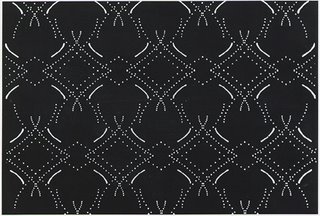 Two Space
by
Call Number: Motion Picture 16082 reel 1Publication Date: 1979OCLC#: 823931189
Two Space
by
Call Number: Motion Picture 16082 reel 1Publication Date: 1979OCLC#: 823931189
Located under title "Animated shorts, 1957-1981", reel 1 -
T.Z.Call Number: Motion picture 16082 reel 1Publication Date: 1978OCLC#: 823931189
Located under title "Animated shorts, 1957-1981", reel 1. -
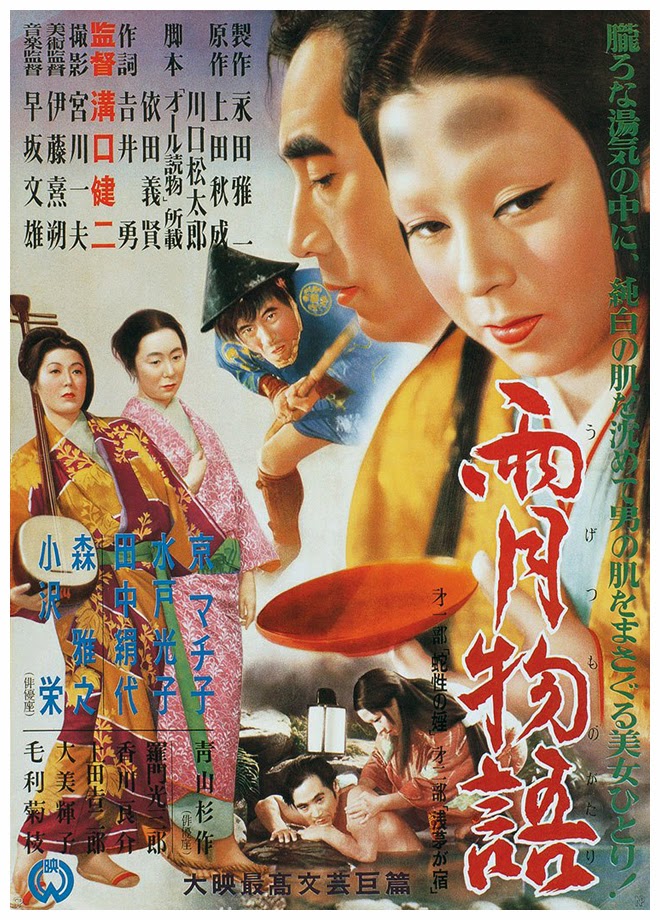 Ugetsu
by
Call Number: Motion Picture 16057Publication Date: 1954OCLC#: 127108065
Ugetsu
by
Call Number: Motion Picture 16057Publication Date: 1954OCLC#: 127108065
Ugetsu is one of the most moving and beautiful works of Japanese cinema. Directed with insight and sensitivity by Kenji Mizoguchi it is set in 16th century war-torn Japan. Two peasant families leave their homes in search of fortune. The husbands abandon their wives and children along the journey. Mizoguchi utilizes an exquisite sense of the past and the world of the supernatural. It enables him to successfully portray how war leads to restlessness and greed. -
 Ukigusa monogatari (Story of Floating Weeds)
by
Call Number: Motion Picture 16074Publication Date: 1934OCLC#: 756693977
Ukigusa monogatari (Story of Floating Weeds)
by
Call Number: Motion Picture 16074Publication Date: 1934OCLC#: 756693977
Yasujiro Ozu is considered “the most Japanese of Japanese directors”. The film, which was produced in 1934, is the pinnacle of his silent period. It depicts a down-at-the heels acting troupe which reaches the end of the line in a remote mountain village. -
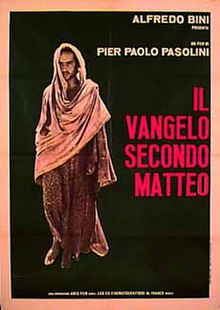 Il Vangelo secondo Matteo (Gospel According to St. Matthew)
by
Call Number: Motion Picture 16003Publication Date: 1964OCLC#: 751465392
Il Vangelo secondo Matteo (Gospel According to St. Matthew)
by
Call Number: Motion Picture 16003Publication Date: 1964OCLC#: 751465392
Italian/English subtitles
Pier Paolo Pasolini, Italy’s controversial writer-poet-director, has avoided the spectacular over-dramatization so characteristic of films on Jesus’ life. “I haven’t put the gospel together,” he has stated, “and written a scenario of the life of Christ; this is precisely the Gospel According to Saint Matthew.” Pasolini’s unconventional approach is reflected in his use of rugged southern Italian landscapes, hill town, costumes of coarse material, and faces without makeup. There are no “stars” all of the performances are non-actors whom Pasolini selected for their natural unglamorous quality. Pasolini’s Christ is a man who preaches with urgency; feels deeply for the afflicted people around him; experiences anguish, impatience, and anger. The film is basically a simple recreation of human drama, set against the everyday life of the times. -
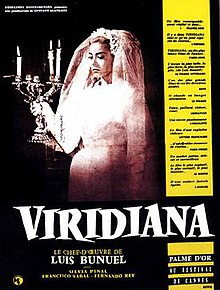 Viridiana
by
Call Number: Motion Picture 16010Publication Date: 1961OCLC#: 321035077
Viridiana
by
Call Number: Motion Picture 16010Publication Date: 1961OCLC#: 321035077
After a 23 year exile, Luis Buñuel returned to Spain to direct Viridiana, which won the Grand Prize at the Cannes, and which many consider a masterpiece. A devastating, outrageous attack on religion and society, Viridiana is a further elaboration on the subject of Nazarin: the impossibility of living a pure Christian life. The film has a consistently disturbing atmosphere, created by some of Bunuel’s most unusual erotic and religious imagery. In the famous orgy scene, everything which society holds sacred is demolished--the beggars fight, dance, and make love while Handel’s “Messiah” plays in the background. -
Vitagraph romance byCall Number: Motion Picture 16112Publication Date: 1912OCLC#: 827797005
Located under title "Early Cinema Reel II"
8min. The special delight of this drama is that it shows the Vitagraph lot in Brooklyn and the making of movies there. The plot revolves around a senator’s daughter who is disowned when she marries a penniless writer and reconciled with her father after becoming a famous motion picture actress. -
 Vivre sa vie (My Life to Live)
by
Call Number: Motion Picture 16025Publication Date: 1962OCLC#: 20783616
Vivre sa vie (My Life to Live)
by
Call Number: Motion Picture 16025Publication Date: 1962OCLC#: 20783616
In twelve segments, Nana goes from wife and mother into casual promiscuity and then to the harder world of prostitution. However, this is not a film about prostitutes, or women who desert their husbands. Director Jean-Luc Goddard makes films about ideas. “My three films all have, at the bottom, the same subject. I take an individual who has an idea, and who tries to go to the end of his ides.” Godard said in an interview in 1961 in “L’Express”. This film is about idea of freedom--it’s a minute exploration of the conditions, the qualities, and the problems of freedom. -
 Voyage a travers L’impossible (Impossible voyage)
by
Call Number: Motion Picture 16113Publication Date: 1904OCLC#: 864630888
Voyage a travers L’impossible (Impossible voyage)
by
Call Number: Motion Picture 16113Publication Date: 1904OCLC#: 864630888
Listed under title "Early Cinema Reel III".
14min. Tinted. A fantastic adventure-spectacle in the tradition of Melies' A Trip to the Moon 1902. -
 Waiting at the church
by
Call Number: Motion Picture 16111Publication Date: 1906OCLC#: 827791442
Waiting at the church
by
Call Number: Motion Picture 16111Publication Date: 1906OCLC#: 827791442
Listed under title "Early Cinema Reel 1: Edwin S. Porter"
7min. The film, showing what happens when a miscreant married man is tempted to propose to a young lady, is a typical chase comedy. It contains a “daydream” inserted in the same shot with the woman who imagines it, the kind of trick effect that was a Porter specialty. The film was probably suggested by the newly introduced popular song of the same title. -
 Wavelength
by
Call Number: Motion Picture 16051Publication Date: 1967OCLC#: 842929930
Wavelength
by
Call Number: Motion Picture 16051Publication Date: 1967OCLC#: 842929930
This film is a non-continuous zoom which takes 45 minutes to go from its widest field to its smallest and final
field. As an underground film, it is a straightforward document of a room in which a dozen businesses have come and gone. For all of its sophistication, (and it is overpowering for its time-space-sound inventions) it is a singular uncomplicated, and realistic way to view three walls, a ceiling, and a floor. -
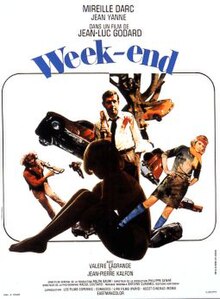 Weekend
by
Call Number: Motion Picture 16021Publication Date: 1968OCLC#: 43995021
Weekend
by
Call Number: Motion Picture 16021Publication Date: 1968OCLC#: 43995021
French/English subtitles
Cinematically revolutionary, Weekend is full of rage, violence, and cruelty. It is also full of tender poetry, metaphors, and exciting imagery. The film has many Godardian themes, including the consumer society and the horror of the bourgeoisie. Godard has every sequence serve to destroy the illusory reality of the previous experience, so that we are constantly reminded we are watching a film. The result is brilliant, extraordinary cinema. -
 Window Water Baby Moving
by
Call Number: Motion Picture 16098Publication Date: 1959OCLC#: 52469579
Window Water Baby Moving
by
Call Number: Motion Picture 16098Publication Date: 1959OCLC#: 52469579
Brakhage’s treatment of the birth of his first daughter is a picture so forthright, so full of primitive wonder and love, so far beyond civilization in its acceptance that it becomes an experience like few in cinema. -
Wringing good jokeCall Number: Motion Picture 16113Publication Date: 1899OCLC#: 864630888
Listed under title "Early Cinema Reel III". -
 Xala
by
Call Number: Motion Picture 16087Publication Date: 1974OCLC#: 156934357
Xala
by
Call Number: Motion Picture 16087Publication Date: 1974OCLC#: 156934357
Wolof and French/English subtitles
Zeroing in on the myth of African independence and the black-facing of white colonial policies by African leaders, this savage and funny satire deals with a self-satisfied, half-westernized black businessman who is suddenly struck down by the Xala (pronounced “ha-la”): a curse rendering its victim impotent. While he desperately chases after witch doctors and soothsayers in search of a cure, his impotence becomes a mirror of the impotence of young African nations that are over-dependent on white technology and bureaucratic structures. -
 Young Mr. Lincoln
by
Call Number: Motion Picture 16068Publication Date: 1939OCLC#: 756765369
Young Mr. Lincoln
by
Call Number: Motion Picture 16068Publication Date: 1939OCLC#: 756765369
Director John Ford utilized a young, charming and gangly Henry Fonda in this fictionalized portrait of Abraham Lincoln, a man with a gift for using simple language to reveal elusive truths. The result is a legendary masterpiece that has grown in stature over the years. -
 Zerkalo (Mirror)
by
Call Number: Motion Picture 16071Publication Date: 1976OCLC#: 317360525
Zerkalo (Mirror)
by
Call Number: Motion Picture 16071Publication Date: 1976OCLC#: 317360525
Russian/English subtitles
It depicts cracked, jagged, and jumbled images of Andrei Tarkovsky’s childhood, mixed with fragments of his adult life----a child’s wartime exile, a mother’s experience with political terror, the breakup of a marriage, life in a country home---all intermingled with slow-motion dream sequences and segments of stark newsreels. -
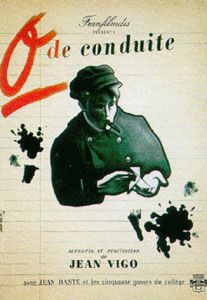 Zéro de conduite (Zero for Conduct)
by
Call Number: Motion Picture 16007Publication Date: 1933OCLC#: 823641344
Zéro de conduite (Zero for Conduct)
by
Call Number: Motion Picture 16007Publication Date: 1933OCLC#: 823641344
French /English subtitles
Jean Vigo who died in 1934 at the age of 29, was one of film’s most original and remarkable talents. His masterpiece, tells of the oppressive life in a French boarding school and the eventual revolt of the boys. The entire film is filled with stylized sequences, climaxing in a lyrically photographed dormitory riot and procession. Because of its attack on French educational methods, the film was banned in France for 16 years. -
 Zorns Lemma
by
Call Number: Motion Picture 16091Publication Date: 1970OCLC#: 317400943
Zorns Lemma
by
Call Number: Motion Picture 16091Publication Date: 1970OCLC#: 317400943
It began as a series of 2,000 black and white still photographs of the urban environment, later re-shot in color with a motion picture camera. It has three parts: First is image-less as a woman’s voice reads couplets about each of the letters of the Bay State Primer, used to teach the alphabet to children. The second part is forty five minutes long, totally silent, and consists of over 2,500 images, each one second long. The longest metrical editing exercises in film history, each presents a record of a different word appearing on a store sign, a wall mural, etc. Part three is a long take of a snowstorm in a white field, which is gradually traversed by a couple and a dog until they disappear into the distant woods. Five separate rolls of film were spliced end to end to present a continuous field of action. This movement is now accompanied by a soundtrack-the talkie has now emerged-which is taken from Robert Grosseteste’s eleventh century essay, “On the Light or the Ingression of Form” childhood emerging from conceptual darkness through literacy, and then toward an apprehension of the world through photography and then through cinema. -
 Zvezdy I soldaty (Red and the White)
by
Call Number: Motion Picture 16107Publication Date: 1968OCLC#: 823931993
Zvezdy I soldaty (Red and the White)
by
Call Number: Motion Picture 16107Publication Date: 1968OCLC#: 823931993
Russian/English subtitles
In Central Russia during the Civil War of 1918, an abandoned monastery and a field hospital are silent witnesses to the endless conflicts between opposing armies. This is a moving visual feast where every inch of the cinemascope frame is used to magnificent effect.